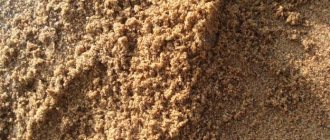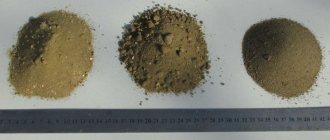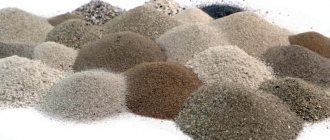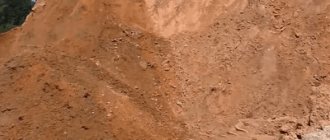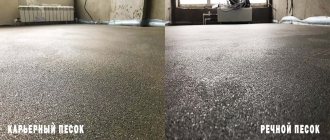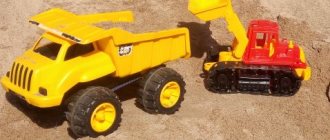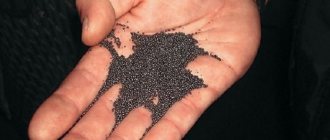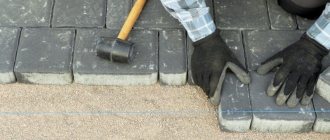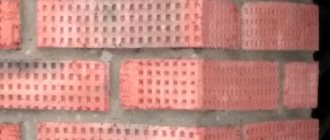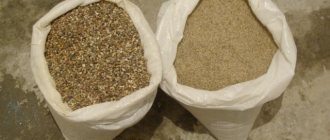Quarry sand is one of the types of sand that is mined in quarries. Thanks to its good technical characteristics, it has a wide range of applications, including in construction and design of personal plots. Deposits with it are located close to the surface of the earth. Sand was formed as a result of the destruction of rocks. Therefore, it consists of many fractions of different sizes - from 0.1 to 5 mm.
Excavators, bulldozers and other equipment are used for mining. First, the top earthen layer is removed, since it is under it that there is sand. After that, access roads are developed and removal is carried out by trucks. Purification of impurities most often occurs immediately on site.
Types of construction sand
Sand can be of natural or artificial origin.
Natural sand : this is river sand, quarry sand, and dune sand. This material, in most cases, has a yellow color (from light yellow to brown) and a fine granular structure.
Quarry - mined by open pit mining. Quarry sand contains many clay impurities. Alluvial - after the extracted sand is washed in order to reduce the amount of unnecessary impurities, its quality increases significantly. That is why it is called alluvial or seeded. Used in the preparation of solutions or concrete products.
River sand is less contaminated with impurities, more free-flowing, but includes pebbles up to 10 mm.
Sea sand – mined at sea and transported on cargo ships. This type of sand is considered the cleanest.
Screened sand is sifted sand, cleared of stones and large fractions.
Alluvial sand according to GOST 8736-93 is a non-metallic material obtained by washing ordinary quarry sand. The sand is washed with a large amount of water, clay and dust particles are washed out of it. Typically, alluvial sand comes in very fine fractions (on average 0.6 mm.)
Sand of artificial origin is a rock that has been crushed to the desired grain size. Sand from rocks such as marble and granite is used in the production of decorative mortars, in the production of decorative and finishing materials, in facade and interior plasters, and landscape design. In particular, quartz sand is also obtained from white quartz. It is characterized by homogeneity and high intergranular porosity. It has a high sorption capacity, high resistance to mechanical, chemical, and atmospheric influences.
Depending on the grain composition, sand is divided into groups by size:
Class I - very coarse (sand from crushing screenings), increased coarseness, coarse, medium and fine;
Class II - very coarse (sand from crushing screenings), increased coarseness, coarse, medium, fine, very fine, fine and very fine. (GOST 8736-93)
| Sand group | Size module Mk |
| Very large | St. 3.5 |
| Increased size | >> 3.0 to 3.5 |
| Large | >> 2,5 >> 3,0 |
| Average | >> 2,0 >> 2,5 |
| Small | >> 1,5 >> 2,0 |
| Very small | >> 1,0 >> 1,5 |
| Thin | >> 0,7 >> 1,0 |
| Very thin | Up to 0.7 |
Mining and enrichment
Based on the needs of a particular construction site, developers request sand of a specific grain size and cleaning quality. Not every region has the sand deposits needed to solve these needs, and delivery from neighboring regions will become more expensive. To eliminate such a problem, it is necessary to enrich the sand - the reagents that interfere with the quality and parametric indicators that got there “under their own power” are removed from it, and in return the material that is missing in volume and mass is introduced in order to fulfill the plan for the supply of such sand without deteriorating its properties.
Recommendations for the use of construction sand
The foundation is the main part of any building. That is why it requires high strength and stability. Alluvial quarry sand is best suited for this type of work . Using such sand will not hit your budget. It also meets safety requirements.
For mortar masonry , use river sand with a grain size of about 2.5 mm.
For floor screed - It is best to purchase washed sand that has natural moisture.
For plastering, it is recommended to use river or sea sand; it is worth saying that using ordinary quarry sand (without clay impurities) will be sufficient. For these works it is better to use inexpensive types of sand.
For drainage in the foundations of various structures, or drainage during the construction of septic tanks and treatment facilities, river or sea sand is used.
For the production of glass and foundry molds – river and sea sand.
For concrete, sand is standardized according to GOST 10268-80 Medium-sized river (sea) sand is used as a filler for heavy, light, fine-grained, cellular and silicate concrete, mortars and for the production of dry mixtures.
Coarse quarry (mountain) sand is used to construct foundations and surfaces for roads and airfields.
For the production of decorative plasters , as a filler for the installation of floor polyurethane or epoxy coatings - river (sifted) or sea sand.
For the production of polymer sand products, it is recommended to use construction sand, medium class
- Sand class by grain composition: ………………………….1 class
- Sand size group: ……………………………………. "average"
- Sand fineness modulus: …………………….. Mk over 2.0 to 2.5
- Total residue when sieving sand on a sieve with a mesh of 0.63: over 30 to 45%
- Content of grains finer than 0.16 mm: ……………………UP TO 5%
- Content of grains larger than 10 mm: ……………………… up to 0.5%
- Content of grains larger than 5 mm: …………………….. up to 5%
- Content of dust and clay particles……………………. up to 1%
- Bulk density in natural moisture state 1630 kg/m3
- Sand filtration coefficient…………………………….. 7 m/day
- Mineralogical and petrographic composition of sands (predominant content):
- quartz 54.09 - 68.54%
- granite 10.31 - 13.83%
- feldspar 7.07 -7.97%
- limestone 6.13 - 7.96%
- dolomite 0-2.91%
- siliceous rocks 1.24 - 1.98%
- quartzite 0.21 - 0.39%
- mica 0-0.63%
- sandstone 0.05 - 0.92%
- slate, gneiss 0-0.38%
- glauconite 0-0.18%
- iron hydroxides 0.04 -0.25%
- ore hydroxides 0.07 -0.27%
- accessory minerals 0.26 - 0.56%
- Average chemical composition of construction sand
Sl02 Al2O3 Fe203 Ti02 CaO MgO SO3 K2O Na2O P.P.P. 1000 C Sum CO2 content CaCO3 78,26 6,48 1,45 0,12 5,89 0,70 0,12 0,96 0,64 5,35 99,97 4,92 11,2 - The content of amorphous varieties of silicon dioxide, soluble in alkalis, is no more than 50 mmol/l.
- The content of sulfur and sulfuric acid compounds in terms of SO3 ranges from 0.1 00.30%.
- The content of organic impurities (humic substances) in the sand when treated with a solution (sodium hydroxide - the liquid above the sample is lighter than the standard.
- The true density of sand grains is 2.62 - 2.65 g/cm3.
- Sand class according to the specific effective activity of natural radionuclides: 1st class of use up to 370 Bq/kg.
The extraction process is staged:
- Having discovered sand deposits, after excavating it from the subsoil, the material is sorted into fractions, sifting out grains larger than 5 mm, using vibration shaking on a special device. When shaking, large particles tend to occupy the uppermost position in the layer of sand being processed, as a result they are easy to remove.
- What remains is cleaned of clay and other deposits using a wash tank, with a large amount of water passing through the sand, then the washed sand is dried by hot blowing.
- If washing the sand is impossible, it can be cleaned using the same blowing, but before that the batch of sand is rubbed to remove as much dirt as possible from the grains of sand. In this case, 100% cleansing is not possible; it is still preferable to wash the sand, otherwise it will not be considered a building material of the highest quality.
- Particles of quartz, crushed stone and stone screenings are introduced into the purified sand, which makes it possible to obtain enriched sand of good quality.
In the case of river sand, enrichment is carried out similarly. River enriched sand is obtained in a similar way. Large particles should not be introduced into fine- and medium-fraction sand - a narrow spread in particle size is carefully maintained.
Main advantages
Enriched sand is much more profitable than simple or purely quartz sand: the poured sand material can easily be stored in open space, but before packing and mixing sand into concrete, the water content in it must be checked. When delivering sand, the material itself goes through the necessary stages of monitoring its condition, right up to the time a particular batch reaches the customer’s construction site. Loss of strength after construction work is almost completely eliminated - there is no clay or other inclusions that spoil its composition in the sand.
Compared to ordinary sand, enriched sand, when transported in bags, is packaged in 25 or 50 kg bags, this makes it possible to bring it to the construction site in an uncontaminated state - even the penetration of road dust into the packaged sand is eliminated. Prices for packaged enriched sand as of 2020 are about 150 rubles. for 50 kg, the actual price depends on the delivery region and the specific company.
Industrial Applications
River sand of the middle fraction contains practically no admixtures of clay or solid particles, therefore it is valued as a high-quality building material. Structures created using it do not shrink. Therefore, it is used in the production of concrete and working mortars for brick and stone masonry.
Building material that is mined using a quarry method contains particles of soil and clay. It is most often used when laying the foundation, for preparing a plaster mixture for rough finishing, for filling roads, and installing drainage systems.
Artificial medium-grained sand is resistant to chemicals and does not contain impurities, therefore it is used for the preparation of grinding compounds, the production of bricks and cinder blocks, and decorative wall decoration.
Guarantees
Some companies, trying to earn more, present for sale as enriched sand an ordinary “different grain” that has not undergone additional purification or has passed through, but is not really enriched (or under-enriched). To avoid falling for such fraud, use sand delivery from companies that closely cooperate with quarry miners - they will definitely not allow inconsistencies, because sand is enriched at the site of its extraction.
Each such organization or company must provide a quality certificate issued based on an assessment based on the results of laboratory tests. Development companies, which have hundreds of successfully constructed high-rise buildings, collect copies of these certificates and keep them - if necessary, read their reviews and make sure that these documents are not forged.
Bulk density
The bulk density value is the ratio of the volume and mass of fine sand. The higher the density, the greater its weight. This indicator is important to take into account when calculating the need for building materials.
Bulk density depends on several indicators:
- Humidity
- Porosity
- Presence of impurities
In our region, the indicator of this property for fine sand varies from 1,412 to 1,420 kg/m3.
Read more about this characteristic on the page Bulk density of bulk materials. Bulk density indicators for different types of sand can be found on our page Bulk density of sand (comparative characteristics).
Why is sand enrichment necessary?
Enriched sand is mainly used directly in the construction of buildings and the construction of roads, paths, and platforms for various purposes. Enriched sand has good flowability, and structural elements built on its basis acquire very satisfactory strength. To make concrete for the same foundation or supporting base, coarse enriched sand is used, which makes it possible to maintain the strength of the resulting frame element, slab or block with less cement consumption.
For road construction, enriched sand better allows water to pass through the sides and drains it more efficiently, eliminating stagnation, which leads to waterlogging of the road base, the formation of mold and duckweed, which destroy any material. The road does not fall apart and the asphalt surface does not crack.
